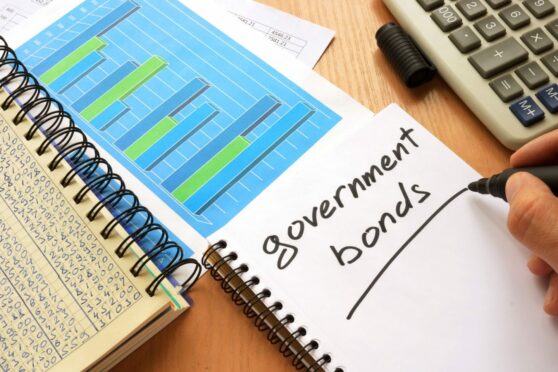What are gilts and how are they tax-efficient? Stuart Lamont, assistant director investment management at RBC Brewin Dolphin, explains more.
-
Some Press and Journal online content is funded by outside parties. The revenue from this helps to sustain our independent news gathering. You will always know if you are reading paid-for material as it will be clearly labelled as “Partnership” on the site and on social media channels.
This can take two different forms.
“Presented by”
This means the content has been paid for and produced by the named advertiser.
“In partnership with”
This means the content has been paid for and approved by the named advertiser but written and edited by our own commercial content team.
Rising interest rates and cuts to the capital gains tax (CGT) exemption are making UK government bonds, or gilts, an attractive option for investors.
The release of the latest UK inflation numbers has seen gilt yields approach the levels they hit in the wake of last autumn’s mini-budget. This may create buying opportunities for some higher and additional-rate taxpayers, for whom the CGT-exempt status of gilts can be particularly beneficial.
Here, we explain how gilts work and why they can play a useful role in tax-efficient investment portfolios.
What are gilts?
Gilts are secure savings vehicles which are guaranteed by the government and listed on the London Stock Exchange. When they were first issued, the certificates were printed on paper with a gilt edge, which is where they got their name.
Gilts pay out regular income, known as a ‘coupon’. Most government bonds are issued at a price of £100 and the coupon is set as a fixed percentage of the issue price. The coupon rate usually reflects the market interest rate at the time the bond was issued.
When a gilt reaches the end of its term, the full face value of the bond is repaid. This is known as the ‘principal’. If you buy a gilt when it is issued and hold it until its maturity date, your initial capital will be repaid. If you buy a gilt mid-way through its term, the amount you receive back at the end of its term will depend on whether the gilt was trading above or below ‘par’ (face value) at the point of purchase.
Why have yields risen?
Bond prices and yields are inversely related, so when the price falls the yield rises, and when the price rises the yield falls.
Bond prices are particularly impacted by changes in interest rates. In a rising interest rate environment, bond prices tend to decline. This is because the coupon rate, and therefore the yield, on newly issued bonds will be higher than on old bonds that were issued when interest rates were low.
The only way for those old bonds to remain competitive is to lower their price so that their yields increase.
Some of the gilts that are in the market at the moment were issued shortly after the Covid-19 pandemic, when interest rates were at historic lows. Over the past year, rising interest rates have resulted in these gilts trading at a significant discount to their face value.
When bonds trade at a discount, it can sometimes be a buying opportunity for investors who are able to withstand the daily volatility in prices and can hold these gilts until their prices start to recover; bond prices tend to approach their face value as they near their maturity date.
If held to maturity, investors will get back the full face value amount (subject to the government not defaulting on its repayments).
Why are gilts tax efficient?
Gilts are completely free from capital gains tax, which means you do not have to pay CGT on any profits you make when you sell or redeem the gilt.
This is particularly useful for higher and additional-rate taxpayers who would otherwise pay CGT at 20%.
This year has seen the CGT exemption – the amount of capital gains you can make without being taxed – cut from £12,300 to £6,000.
The CGT exemption is due to be slashed again in 2024/25 to just £3,000. Finding ways to invest more tax efficiently has therefore become even more important.
At the moment, gilts are also attractive from an income tax perspective.
One way of demonstrating this is to compare them with savings accounts. In a taxable savings account, the whole return is classed as interest. Anything over your personal savings allowance is taxed at your marginal rate of income tax.
With a gilt, you only pay income tax on the coupon.
Gilts issued shortly after the pandemic have extremely low coupon rates and so pay out very little interest. This means the largest chunk of overall returns is likely to come from capital gains as opposed to income.
As of Friday June 28, a UK gilt with an expiry date of January 31 2024 had a coupon rate of 0.125% and traded at £97.14. For an additional-rate taxpayer (top rate in Scotland), this equates to a net annual yield to redemption of 5.07%.
To achieve that same yield on taxable savings, the savings account would need to pay interest of 9.22% (or 9.56% for a Scottish top-rate taxpayer).
What role do gilts play in a diversified portfolio?
Gilts can form part of a diversified investment portfolio, alongside other assets classes such as equities and cash.
Gilts with longer maturities are generally more sensitive to interest rate movements than gilts with shorter maturities are, so investing across a range of gilts with varying durations could also help to spread risk.
The role that gilts play in your portfolio will depend on your individual circumstances, including your financial position, how long you are investing for, and your risk appetite.
This isn’t always easy – and that’s where getting some smart advice comes in. A financial adviser can build and manage an investment portfolio that suits your needs, takes advantage of opportunities in the market and is robust enough to deliver long-term performance.
Find out more about gilts from the experts at RBC Brewin Dolphin. You can also contact Stuart directly at stuart.lamont@brewin.co.uk or 01224 267900.
The value of investments, and any income from them, can fall and you may get back less than you invested. This does not constitute tax or legal advice. Tax treatment depends on the individual circumstances of each client and may be subject to change in the future. This information is aimed at individual taxpayers only; the tax treatment for corporate taxpayers is different. Information is provided only as an example and is not a recommendation to pursue a particular strategy. Information contained in this document is believed to be reliable and accurate, but without further investigation cannot be warranted as to accuracy or completeness. Forecasts are not a reliable indicator of future performance.
RBC Brewin Dolphin is a trading name of Brewin Dolphin Limited. Brewin Dolphin Limited is authorised and regulated by the Financial Conduct Authority (Financial Services Register reference number 124444) and regulated in Jersey by the Financial Services Commission. Registered Office; 12 Smithfield Street, London, EC1A 9BD. Registered in England and Wales company number: 2135876. VAT number: GB 690 8994 69

